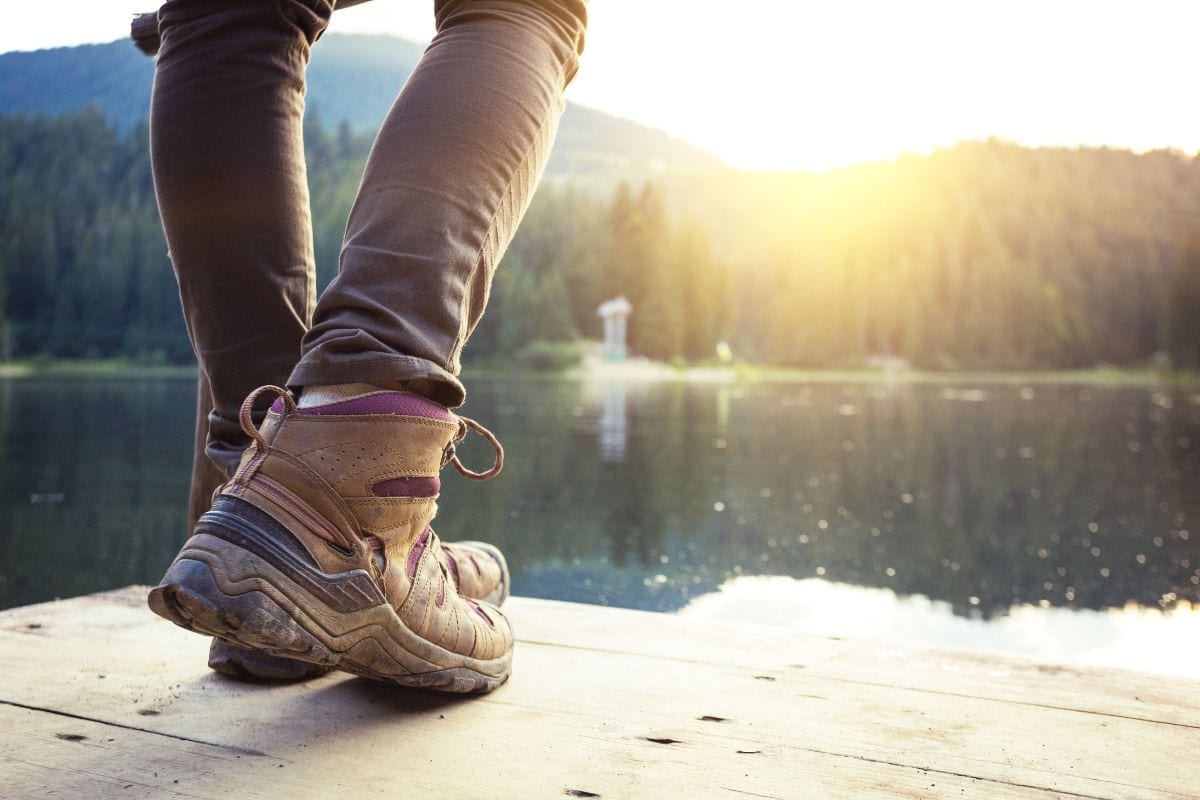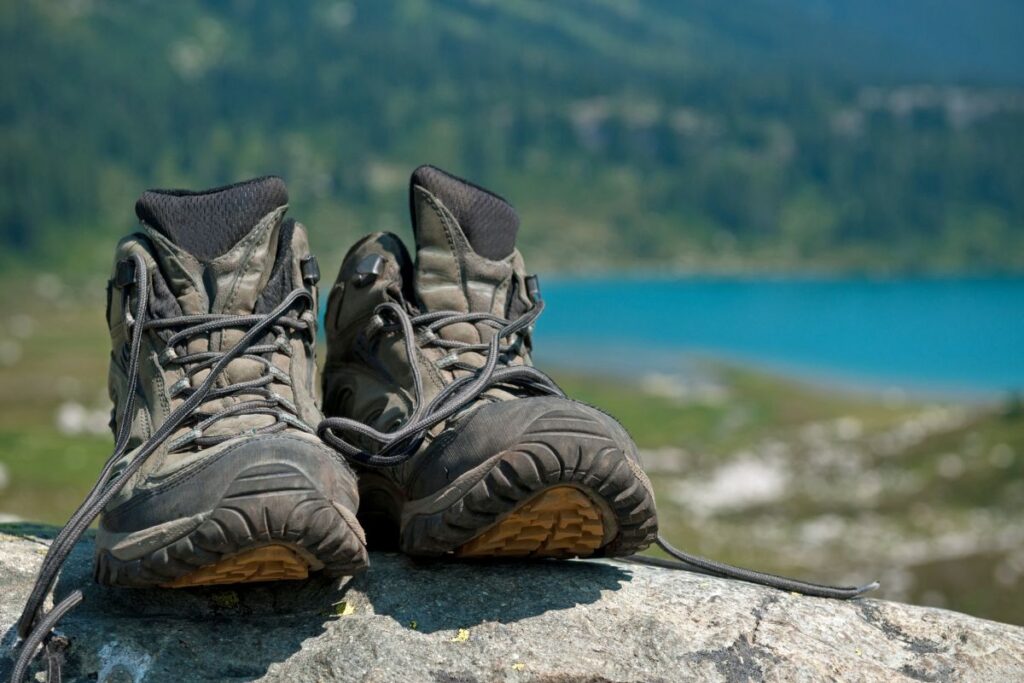We're an affiliate. We hope you love the products we recommend! Just so you know, we may collect a share of sales or other compensation from the links on this page. Thank you if you use our links, we really appreciate it!
How Tight Should Hiking Boots Be?
Hiking boots can make or break your day on the trails and can be the difference between a hike and an adventure!
Blisters can become much more dangerous when untreated and can develop into blood blisters or become infected. Hiking boots are notorious for causing blisters if not worn properly or are ill-fitting.
There are multiple types of hiking boots available – light hiking shoes, backpacking boots, and mountaineering boots. So, you can match your hiking goals with your footwear.
The best hiking boots will fit your feet perfectly, holding your foot securely without constriction or hot spots. Also consider the flex of the boots, breathability, outsole tread, and weight.
Learn more about the best way to wear your boots and how tight they should be to your feet in the rest of this article.
When Should Hiking Boots Be Worn?
Wearing the right footwear can make your hike much more enjoyable. The key to getting the best hiking boots is to match your footwear with the type of hiking you are doing.
There are three types of hiking footwear, each designed for a different level of intensity.
- Light Hiking Shoes – A lower-cut shoe with a more flexible midsole. These shoes are best for day hiking, trail running, and ultra-lightweight backpacking trips. A great choice if your hike includes a variety of terrain and trail conditions that require flexibility and stability without the added weight of a heavier boot.
- Backpacking Boots – High-cut boots will offer additional ankle support. These shoes are more reminiscent of boots and will have stiffer mid-soles to protect the bottoms of your feet from rough terrain. Designed for hikers carrying heavier loads over longer distances.
- Mountaineering Boots – Heavier and more durable than typical hiking boots. Sometimes leather and sometimes plastic with a removable inner boot. Constructed for alpine climbing, glacier crossings, and high altitude. Most mountaineering boots have stiff soles and are designed for use with crampons for climbing or extremely rough terrain.
The durability and ruggedness of mountaineering boots are great when you need them, but on a short day hike, it’s overkill.
They’ll slow you down and feel clunky. Conversely, trail shoes won’t get you very far from climbing snow-covered peaks.
That’s why you should match the flex of your hiking boots to the terrain that you anticipate hiking. For easy, smooth trails, a more flexible shoe will be fine.
As the terrain gets more rugged, so should your footwear.
The Fit Of Your Hiking Boots
Your Toes
The toes are where you want the most space within each of your boots. Make sure you have half an inch or more between the end of your toes and the boot.
When you are hiking down long slopes your foot will tend to shift slightly forward over time. If your toes eventually jam into the end of your boot you’ll be in serious pain and may even lose toenails following your hike.
Even if your toes just barely reach but start to rub on the end of your toenails, life is going to be bad.
Make sure you can wiggle your toes up and down and a little to the sides. Your toes naturally perform balance actions within your boot-given space so make sure they can do their job.

Under Your Arch
You want either a slight gap on the bottom of your arch or light contact when the boots are new.
After breaking hiking boots in there is usually a depression that forms for your heel and ball of your foot causing the arch to get more support than it might seem when first trying them on.
If you have flat feet, post in the comments and I can write a specific piece for that circumstance if there is enough interest.
Middle Of Your Foot
Around the middle of your foot, you should feel gentle snugness on each side. You don’t want the boot to squeeze in enough to compress your foot and you also don’t want your foot wiggling too freely.
If there is too much freedom side-to-side you will lose some of your ankle stability.
Tightness around the sides of your foot can be managed partially by the shape of the boot, partly by how you tie the strings, and how tightly you pull the laces.
Your Heels
The back of your heel should have firm but not uncomfortable contact with the back of the boots. After tying your boots up with appropriate tightness your heel should not move very much at all.
The slipperiness of your socks is how to manage friction that will exist when walking. If you try to manage friction by having space on your heel you won’t have your boots tight enough.
Your Ankles
The sides of your boots should be in contact with your ankle and lower leg for whatever height the boot has.
It should be snug but not super tight. The idea here is that if your boots go up over your ankle, you want the boot to absorb a lot of the pressure if your foot twists sideways unnaturally instead of the ligaments and tendons in your ankle.
If the boot is too loose you won’t get that support and will have greater exposure to ankle sprains or breaks.
Ankle support is especially critical if you are going to be hiking with a heavier pack. The extra weight on your joints if twisted can turn what would have been a minor sprain into a serious one or even a break.
The Top Of Your Foot
The very top of your foot is a little tricky because when your boots break in your heel, the ball of the foot, and toes will have created minor depressions in the sole and will give your foot a bit more vertical space.
Slightly tighter on the top than you might otherwise like is OK as a result but use your judgment about what is too much.
If you have a bony spot that sticks up a little on top of your foot you’ll want to make sure that the hiking boot tongue is a soft material and not a rigid one that will irritate that hard point.

We’re passionate about getting the most from your car when it comes to going on adventures and road trips. When you take one of these trips you often need more room in your car than you usually would. This is when we come in, to help you find the best roof tent for your car and needs.

